Flooding of the Fly Over States, what do you think is causing this and what will it mean for the population?
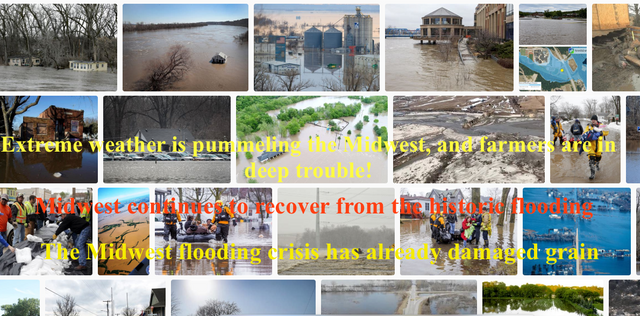
This article covers,
the clip of President Trump being interviewed by George Stephanopoulos see at the bottom.
His meeting on Air Force One in the Flying Oval Office where he speaks to government officials where he is briefed on the state's recent flooding
evidence and source links of other midwest states flooding
how what much of America just thinks of these states that are dubbed the "fly over states," will be affected by this flooding. What it can mean even to the elitists.
Is this intentional? Can this rain be controlled?
If there exists a weather modification group like the West Texas Weather Modification Association who has been cloud seeding for 20 years, don't they have the ability to seed clouds elsewhere?
Some people mock, belittle, those who are part of the establishment or work for large corporations even shell companies looking out for Their own best interests like to downplay farming communities. But a certain song says it best.
Guess what Doesn't Look the Same? Not having enough food on you're plate!
I suppose farming communities simply look at how hard their parents, grandparents worked the land and literally survived by their Own wits! So they just don't appreciate being belittled by those who don't understand the connection between them and their food source!
The midwest has it's own special kind of beauty and if you don't appreciate your soil that provides your fuel. . .then you're in trouble!
These Farmers Deserve our respect and I am grateful we have a POTUS who Get's It! After all his mother's father was a fisherman and crofter. This entailed small-scale food production particular to the Scottish Highlands, the islands of Scotland, and formerly on the Isle of Man.
I know he's been used by a certain group, this song is still spot on!
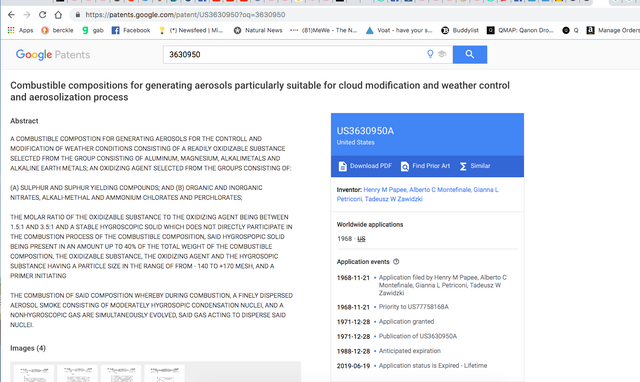
https://patents.google.com/patent/US3630950?oq=3630950
It hasn't just been in Iowa, many farmers are Not planting do to the devastation of the midwest.
Kate Glastetter has worked on her family farm all her life. Alongside her father, the 25-year-old farmer grows row crops—wheat, bean, and corn—and runs a cow and calf operation in Scott County, Missouri. Normally, at this time in the season, farmers would be starting to plant soybeans, and corn should already be in the ground. Instead, Glastetter says, their fields are covered in water. "It's like lakefront property," she says. "The fields are washing away."
It's a common story across the Midwest and Great Plains, where the Missouri and Mississippi River basins are still recovering from a catastrophic deluge
Midwest Farmers Dealing with Flood Water in a Planting Season. Read more at: https://www.newsgram.com/midwest-farmers-floof-water-planting-season/
https://www.newsgram.com/midwest-farmers-floof-water-planting-season/
Extreme weather is pummeling the Midwest, and farmers are in deep trouble
In Kendell Culp’s corner of northwest Indiana, relentless rain began falling on his farm months ago, saturating the ground his family has nurtured for generations and delaying the start of their planting season by more than a week.
It eased up briefly at the end of April, enough time to plant corn on about 350 of his 2,000 acres. Then the rain started falling all over again.
“There’s just not a lot you can do,” he said.
Nearly 90 percent of his corn crop is already growing, as a result of a few dry days and long, strategic hours in the fields. But he has yet to plant a single soybean. Last year, he was done planting everything by the first week of May.
“I’ve never had a yield where I couldn’t get my crop planted,” Culp said, noting that his father, who is in his 80s, recalled the same. “This is unprecedented, what we’re facing.”
This has been pointed to for over 2 years and here we go!
For months now, the Culps — and many farmers across wide swaths of the Midwest — have rarely seen days dry enough to work, leading to what agricultural experts are calling a historically delayed planting season that could exacerbate the economic and personal anxieties brought on by a multiyear slump in farm prices and the Trump administration’s trade war with China, the world’s largest soybean buyer.
Make No mistake it is the Rain. The Washington Post which allows John Podesta linked to pedophilic art and emails to write opinion pieces, fails to state that it was Obama and Clinton who allowed China and other countries to take advantage of the United States with an unfair trade advantage for China over the U.S.
For the past five years, the 18 states that produce the majority of the United States’ corn crop had an average of 90 percent of their fields planted by the end of May, according to data released Tuesday by the Agriculture Department. At the same point this year, 58 percent of the corn crop is in the ground. The outlook for soybeans is just as dismal, with 29 percent in the ground compared with 66 percent in years past.
In individual states, the gap is even more severe. Just 22 percent of the corn crop had been planted as of May 26 in Culp’s home state of Indiana. Soybeans stood at 11 percent.
According to Weather dot com,
Farmers throughout Iowa and Nebraska are reeling after being told that federal disaster aid won’t cover all of their losses, specifically any due to crops that were already harvested before the flood and now sit in swamped grain bins, silos or other storage areas.
The U.S. Department of Agriculture has several programs to help farmers after natural disasters, including assistance in the case of livestock losses or damaged fields, but none specifically to reimburse farmers for lost commodities that are being stored.
Reuters reported today that U.S. Agriculture Under Secretary Bill Northey said the USDA has never experienced this large of a disaster impact on stored crops.
“It’s not traditionally been covered,” Northey told Reuters. “But we’ve not usually had as many losses.”
U.S. farmers have a surplus of certain crops this year is due to years of oversupplied markets, low prices and lost sales from the U.S. trade war with China, previously the biggest buyer of soybeans from the U.S., according to the Reuters report.
As the scope of damage to crops and livestock across Nebraska and Iowa begins to sink in, some farmers say this could be the end of their family businesses.
"This flood may decide it," 72-year-old Mike Stenzel, who lives in Hamburg, Iowa, told the Des Moines Register.
Stenzel estimated he’s lost some 50,000 bushels of stored seed beans and 145,000 bushels of corn to the deluge.
“That’s about $905,000 worth of grain sitting underwater," he told the Register.
Indigo Ag, an agriculture technology company, estimates that up 10 million bushels of corn and soybeans - worth between $17.3 million to $34.6 million - could have been damaged in the floods, the company told Reuters.
A Reuters reporter who flew in a helicopter over Iowa with Northey and other officials described miles of flooded fields littered with lawn chairs, fuel tanks, furniture, tires and other debris. Roads and railways are also swamped or heavily damaged, leaving no way to transport crops or livestock out of the devastation.
There are about 48,000 farmers in Iowa, the vast majority planting either corn or soybeans, according to the USDA. Nebraska has fewer farmers – about 30,000 – but their crops are more diverse and include large amounts of wheat, as well as vegetables such as potatoes and chickpeas. There are 2.1 million farmers spread across the U.S., according to the American Farm Bureau Federation.
See more here,
https://weather.com/news/news/2019-04-02-midwest-floods-farm-aid
The Energy Mix states,
After suffering through the wettest year on record, and with rain continuing to bucket out of June skies, American corn farmers are desperately behind on planting, with little relief in sight and their distress compounded by Donald Trump’s trade war with China and Congressional Republicans’ reluctance to provide flood relief.
“Through all of April and all of May, wave after wave of rain hit the nation right in the breadbasket, with April capping the wettest 12 months on record for the continental United States,” the Washington Post reports. “The past 60 days, in particular, have coincided with planting season in much of the country.”
With yet more rain in the forecast, time is running out, especially for farmers in Illinois and Indiana who have planted only 45% and 31% of their corn, respectively. Even producers in slightly less waterlogged states like Iowa have not yet planted more than 70% of their corn.”
“The coming week’s weather will make or break this year’s crop,” the Post writes.
The problem is worse than it appears, University of Wyoming agronomist Andrew Kniss said in an interview, explaining that planting itself is no guarantee of healthy germination rates. Seeds will struggle in such wet soil, he explained, and the plants that do emerge will likely be stunted.
Ag Daily reports,
As the Midwest continues to recover from the historic flooding, more information is being revealed on the aftermath. The Midwest flooding crisis has already damaged grain and potentially many grain bin structures and is expected to present problems into July, impacting the current planting season.
A geospatial intersection of Farm Market iD’s land data with a flood map from March 16 to 24, 2019, showed that Iowa, Nebraska, Missouri, and Kansas are experiencing significant impacts from the flooding.
Nearly 150,000 growers in the four-state region are affected by the flooding
Nearly 90,000 grain bins are located in the flooded areas valued at $4 billion just for the structures alone
1.24 billion bushels of storage capacity in the affected area — equating to 31 percent of the on-farm grain storage
valued at an estimated $7.5 billion
More than 16 million corn, soybean or wheat acres are located in the affected region
Contaminated grain stored on-farm
With as much as $7.5 billion worth of grain stored in the flooded region, the economic impact on local growers is substantial and comes on top of several years of low commodity prices that have already financially stressed farmers.
“The amount and cost of lost grain and the construction costs to rebuild will impact farmers for years, and some may have a hard time recovering,” said Steve Rao, CEO at Farm Market iD. “That said, the majority of on-farm grain storage has not been affected.”
https://www.agdaily.com/news/growers-acres-affected-midwest-flooding/
According to Best Weather Inc.
As wet weather continues to delay planting across the Corn Belt, some farmers may be considering submitting a claim for “prevent plant” instead of actually planting their intended corn crop. Crop insurance is complicated and each farmer needs to do the calculations for his farm in order to determine if claiming prevent plant is a viable option. Without getting into too much detail (which by the way, I do not know much about), below I have outlined four broad options when it comes to claiming prevent plant.
If a farmer has not been able to plant his corn crop by the insurance date which varies by region, he/she has basically four options.
Option 1 – Submit a claim to the insurance company that he was not able to plant due to excessive wet conditions. Once the claim is accepted, no other crop may be planted on that acreage other than an approved cover crop.
Option 2 – A farmer may plant a second crop before the final planting date for the first crop. For example, if a farmer decides to plant soybeans instead of corn before the final planting date for corn, then the soybean crop will be insured instead of the corn crop.
Option 3 – Submit a claim for prevent plant for corn and then plant soybeans on those acres. The payment for the corn crop will be reduced and the coverage for the soybeans will also be reduced as well.
Option 4 – Plant the original crop during what is called the late-planting period. The late planted period lasts for 25 days after the final planting date for the region. If the crop is planted during this 25-day window, the insurance coverage will decline 1% per day during that period.
Window closing for Midwestern corn farmers to plant crops amid persistent wet weather
All I know is I live in a farming community and our skies are sprayed almost daily! We have documented and have evidence.
Places like this exist and people Still dispute it even when they Literally Tell you what they have been doing!
West Texas Weather Modification Association
The West Texas Weather Modification Association is an Operational Cloud Seeding program that operates over 6 million acres of land in West Texas. The primary goal of the program is to enhance rainfall in convective thunderstorms to help increase dry land crop revenues, decrease groundwater consumption, save on irrigation cost and to help recharge area aquifers while putting some water in area lakes, rivers and reservoirs. Since 2004, the WTWMA has helped increase precipitation by 16%, which translates to an additional 2.25" across the area.
This is Not conspiracy theory as msm and others who wish to pretend this doesn't exist desperately try to tell you.
This Is a Real association. Here is their website,
Seeding operations,
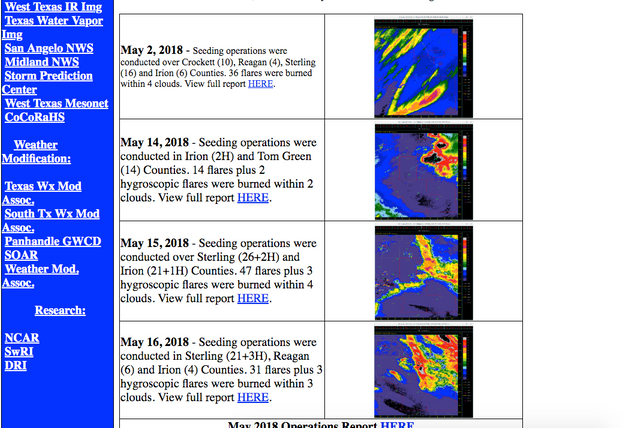
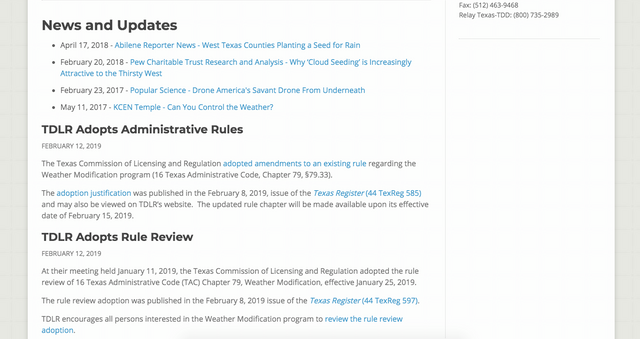
Weather Modification - Weather Modification – Focused efforts to produce additional rainfall using cloud seeding are widespread in much of West and South Texas during the growing season, which extends from early spring until autumn each year. In fact, areas where cloud seeding is concentrated covers about one-sixth of the land area of Texas. The seeding is done primarily for rainfall enhancement using aircraft and sophisticated weather radar data. Decisions to deploy aircraft and disperse seeding materials (both silver iodide and salts) are made by trained meteorologists licensed by TDLR specifically for weather modification. Aircraft are based at airports in various locations within the “target” areas of these projects, i.e. where the impact of seeding (more rainfall from thunderstorms) is intended.
TDLR’s weather modification program issues licenses and permits for these projects, almost all of which have been in operation for 20 years or longer.
TDLR’s program also assists individuals, organizations and governmental bodies in the design of cloud-seeding operations, as well as monitoring ongoing seeding activities to ensure compliance with permits and helping to evaluate the impact of the seeding on “target” and neighborhood areas. It also administers federal grants for exploratory, and confirmatory, cloud-seeding studies and shares information on technological advances with other State agencies, organizations, and interested individuals.
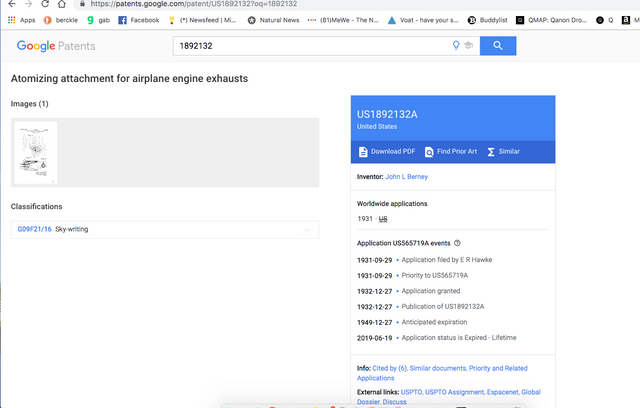
https://patents.google.com/patent/US1892132?oq=1892132
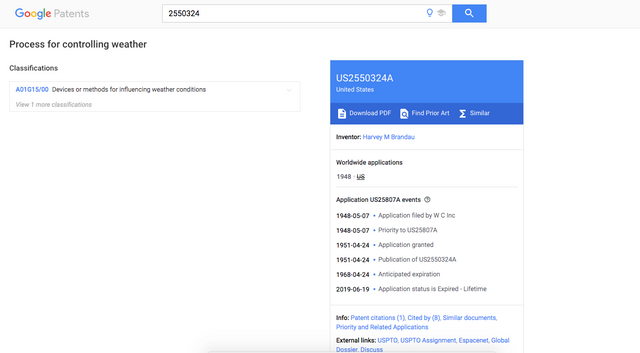
https://patents.google.com/patent/US2550324?oq=2550324
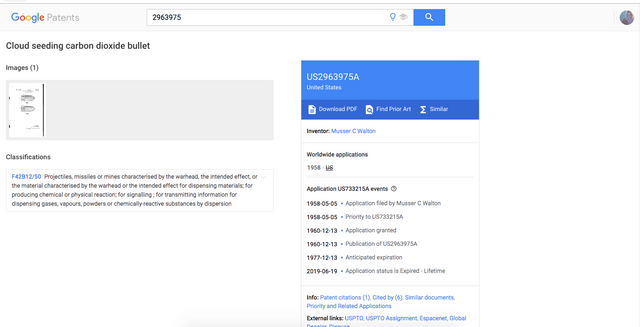
https://patents.google.com/patent/US2963975?oq=2963975
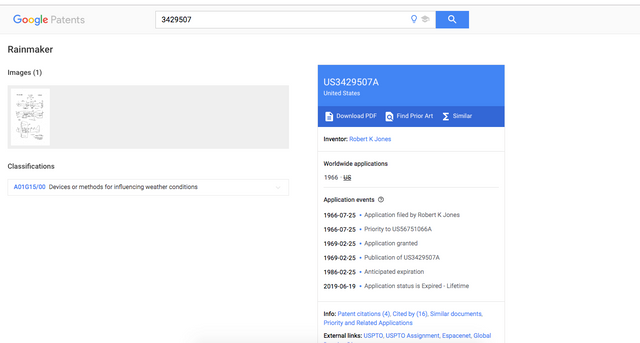
https://patents.google.com/patent/US3429507?oq=3429507
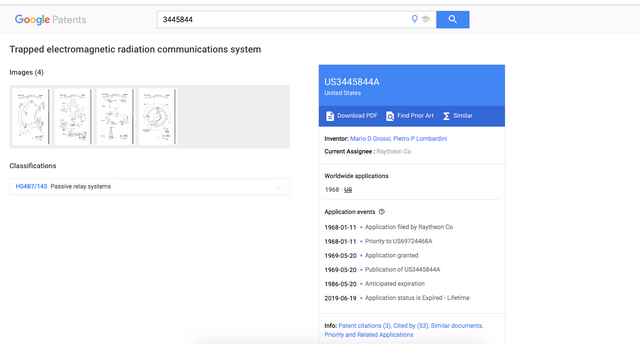
https://patents.google.com/patent/US3445844?oq=3445844
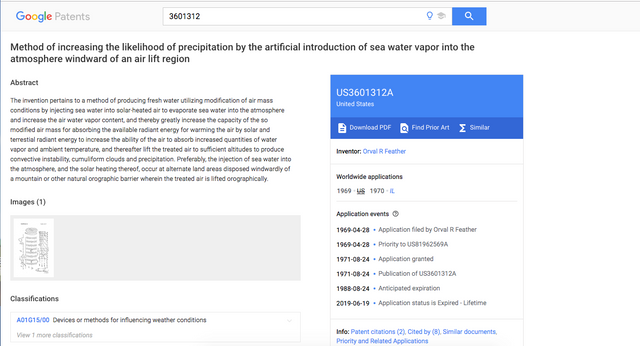
https://patents.google.com/patent/US3601312?oq=3601312
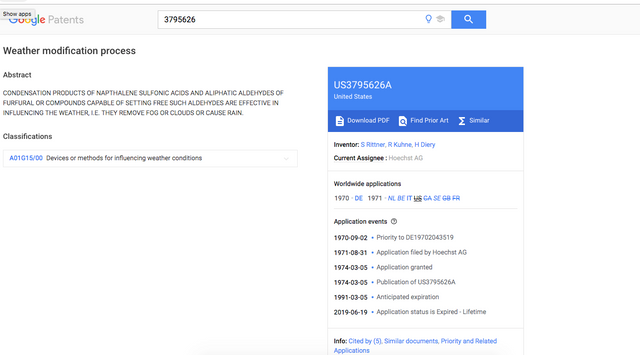
https://patents.google.com/patent/US3795626?oq=3795626

https://patents.google.com/patent/US3994437?oq=3994437
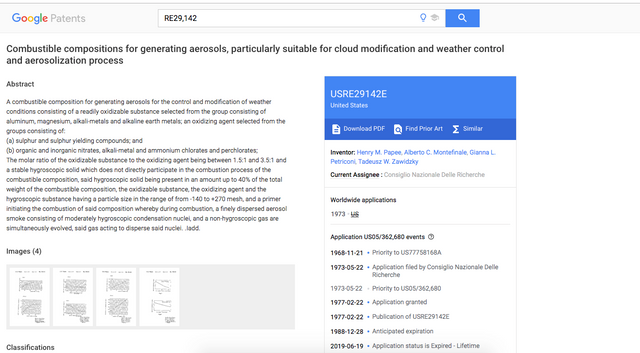
https://patents.google.com/patent/USRE29142?oq=RE29%2c142
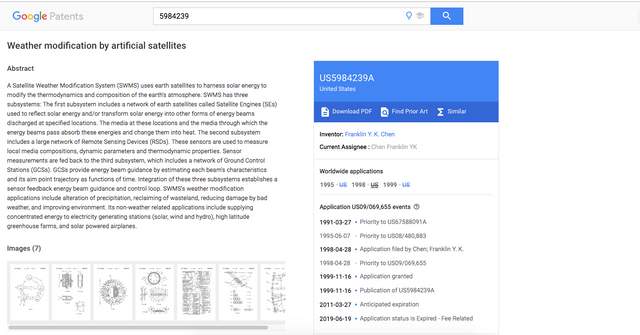
https://patents.google.com/patent/US5984239?oq=5984239
To find out more about this go here on Google weather patents and historical patents dating back to the 1800's go here,
More on this in another article coming soon!
Good thing people were taught to Obey the government or they might think that all of these patents look like the government may not have our best interests at heart.
Have you seen the subliminal messaging from the Star Spangled Banner which Television Stations used to air when they signed off back in the day when TV wasn't aired 24 hours a day?
Here is where someone describes the First Download where if the footage to the song is slowed down, you can see other messaging in between the transitioning of the lyrics.
1960s National Anthem Subliminal Message Analysis
MKNAOMI was the code name for a joint Department of Defense/CIA research program lasting from the 1950s through the 1970s. Unclassified information about the MKNAOMI program and the related Special Operations Division is scarce. It is generally reported to be a successor to the MKULTRA project and to have focused on biological projects including biological warfare agents—specifically, to store materials that could either incapacitate or kill a test subject and to develop devices for the diffusion of such materials.
To learn more about MkNaomi and other covert verified operations go here,
President Trump: 30 Hours l Interview with George Stephanopoulos l Part 1
Tell me what you think of all of this Patriots. Godspeed!
Sources and Connectors,
#AustralianFloods, #Paradise, #SierraMountainFires, #NevadaCity
https://steemit.com/australiafloods/@artistiquejewels/floods-in-australia-the-worst-affected-areas-predominantly-working-class-suburbs-in-southwest-sydney-11-evacuation-orders-issued
Curated for #informationwar (by @wakeupnd)
Ways you can help the @informationwar!